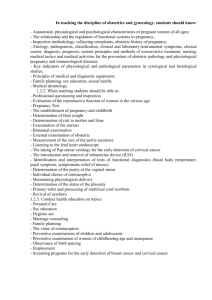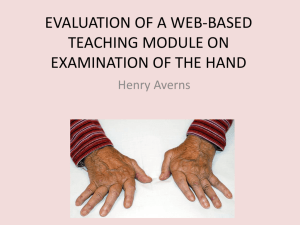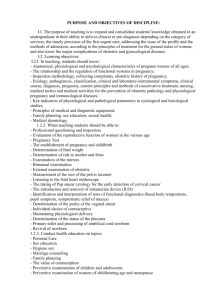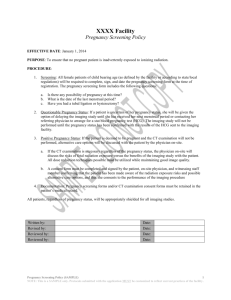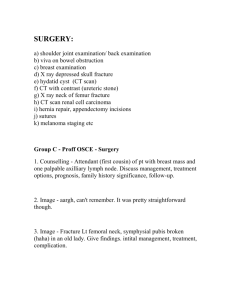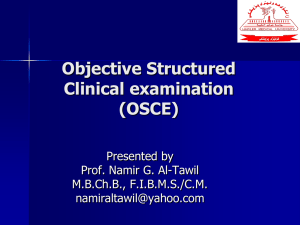OSCE
advertisement
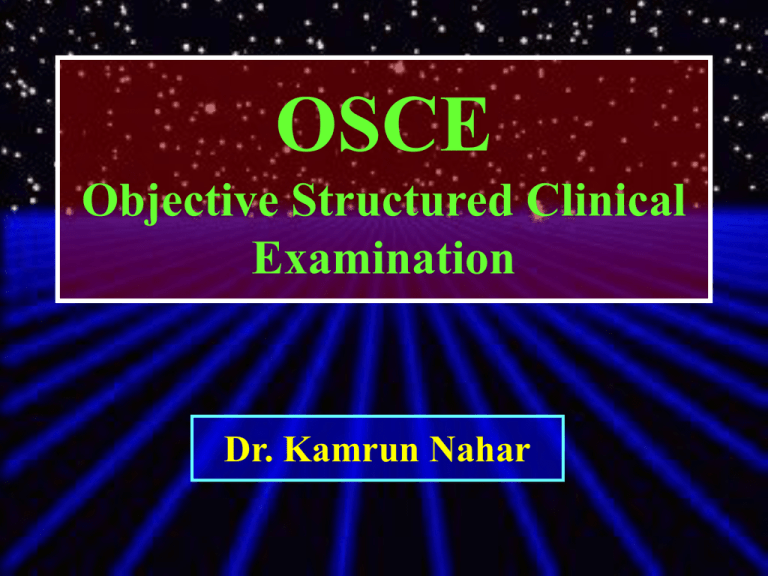
OSCE Objective Structured Clinical Examination Dr. Kamrun Nahar METHODS USED FOR THE ASSESSMENT OF MEDICAL STUDENT Long Essay Questions LEQ. Oral Examination. Short Essay Questions SEQ. Multiple Choice Question MCQ. Modified Essay Question MEQ. Patient Management Problem PMP. Observational Assessment, OSCE, OSPE. LEARNING COMPONENTS Knowledge Dose the student or doctor know what he or she should do? Skills Communication skill Psychomotor skill. Is he or she able to do it? Attitude In practice, dose the student or doctor choose to do it when confronted with a situation? Clinical compentence is demonstrated when a task is performed using learned skills and knowledge. First described by Harden et al in 1975. Communication skill, psychomotor skill, decision making skill and knowledge can be assessed. 20 1 2 P 19 3 4 18 5 17 6 16 7 15 8 14 9 P 13 12 10 11 It consists of 20 station, either practical or written arranged in alternative way. The number of stations can be arranged according to manpower and time schedule of institution. 1 10 9 2 3 4th Year MBBS 8 7 4 5 6 2 for history taking Station 10 3 (Clinical Skill) 2 (Written station) 1 Instrument 1 Rest Total Student : 20 Time Period : 9 am to 11 am 1 10 9 2 3 4th Year MBBS 8 7 4 5 6 Each student starts the examination at a different station. At the end of fixed time period, a bell rings and each student moves on to the next station. At the written station, the student answer a question. At the practical station, the student may be asked to examine the patient, to take history, to examine any investigation report or to use some piece of equipment. Practical station is observed by the examiner with structured check list. How to make station? According to educational objectives. Educational objectives are defined what the student, not the teacher should be able to do. Educational Objective The students must be able to write down the definition of common obstetrical terms like APH/PPH/Gravida etc. reflects student’s knowledge. The students must be able to identify the common obstetric instruments and to know the names of instrument. reflects student’s knowledge The students must be able to estimate the duration of pregnancy and to identify the presentation of an antenatal women. Reflects psychomotor skill Attitude Communication skill Please write down the definition of APH and PPH Please write down the different parts of this instrument. Please palpate the abdomen and write down the duration of pregnancy and presentation. Station 1 : Abdominal examination to estimate the duration of pregnancy and identify presentation. Student’s activity : To do the abdominal examination and to write the duration of pregnancy on given paper. Examiner's activity : To assess the student’s performance by using check list to collect written paper from the student. Time : 5 minutes Resources : A pregnant woman, paper and pen. Estimation of duration of pregnancy and presentation Observational Scale Name of student : Roll No: Efficiently Irregularly Not done done done 1 1/2 0 Consent Maintenance of privacy Keeping the hand for fundal height Keeping the hand for 1st pelvic grip Writing the findings Signature of examiner Criterion : The student must get ---- score out of ---- Station 2 : Factors determining the duration of pregnancy (Written station) Student’s activity : To write down the names of factors determining the duration of pregnancy. Examiner’s activity : To help student about his/ her task, to collect written answer sheet. Time : 5 minutes. Resources : Paper and pen. Station 3 : Feedback to the student is very important for his/her improvement. Usually in OSCE, assessment result making in a specific way is distributed to the student. Assessment result Student’s Name : Roll Number : Batch Number : Your results of assessment are listed below: Station 1 : Abdominal examination to estimate duration of pregnancy Satisfactory/ Unsatisfactory Station 2 : Pelvic examination to determine cervical score Satisfactory/ Unsatisfactory Registrar Gynae and Obs Head of the dept. Gynae and Obs. Why OSCE ? Reliable as all students are asked to do the same tasks. Valid Tasks are according to objectives of course The student is observed during the performance with structured check list. There is difference between knowing how to do something and actually being able to do it. OSCE with existing long case examination can fulfil the goal.
